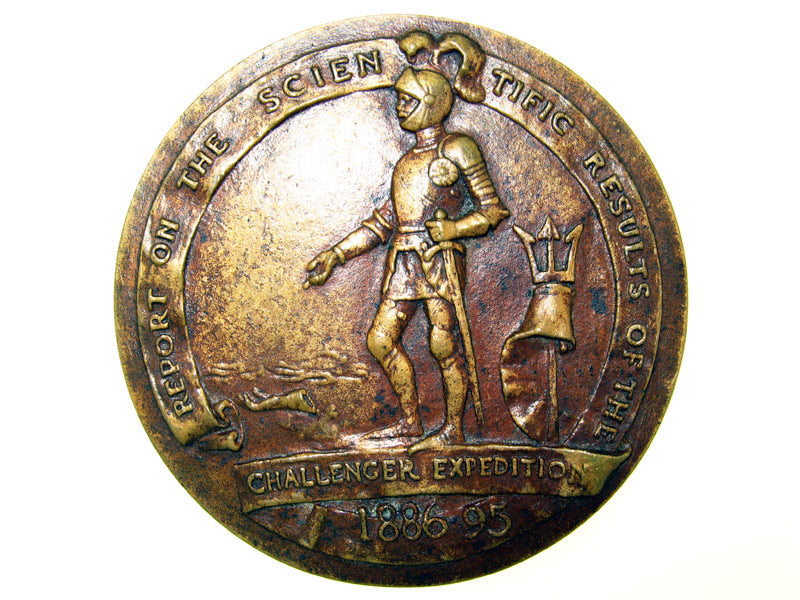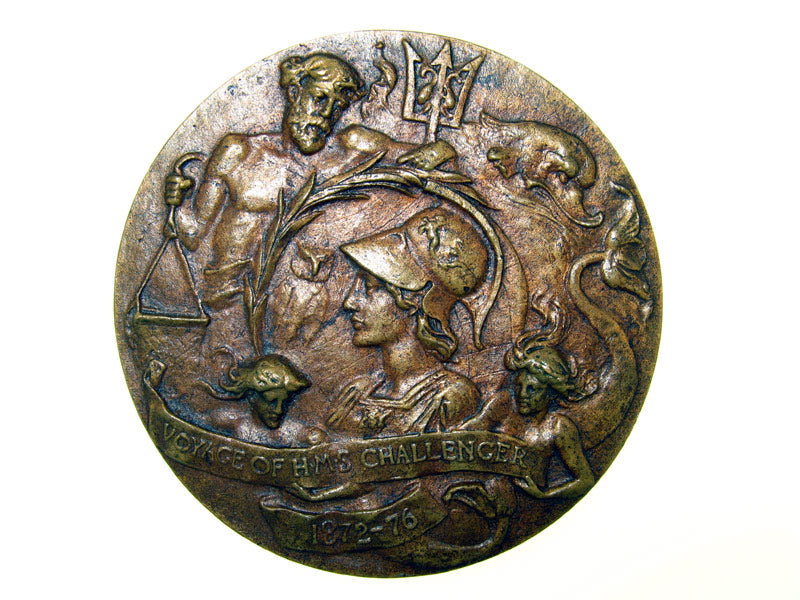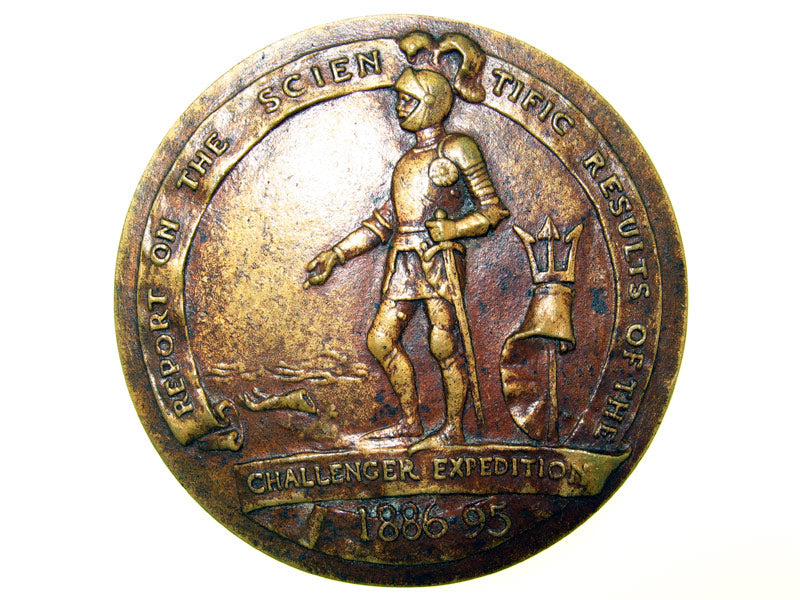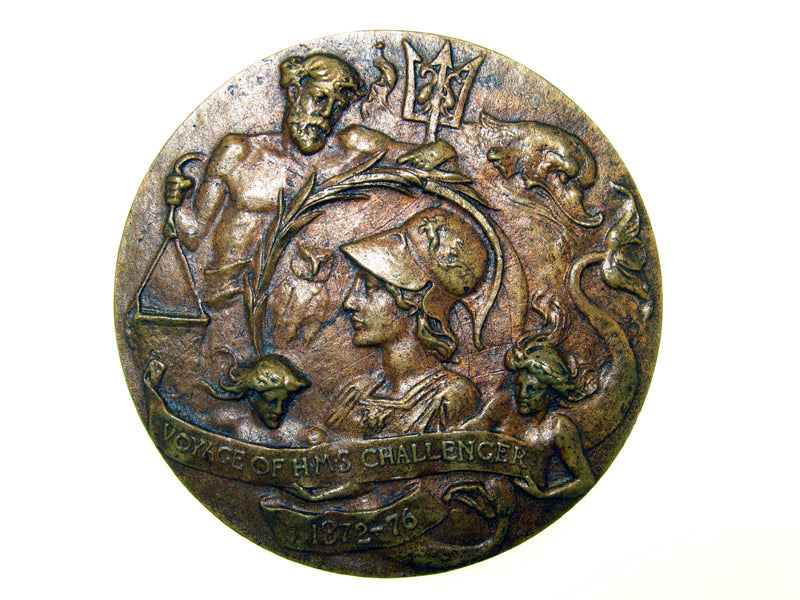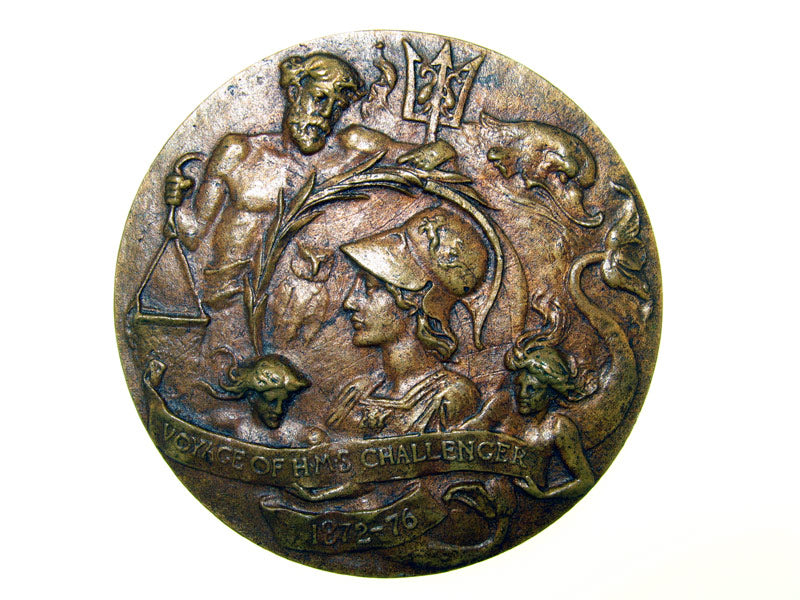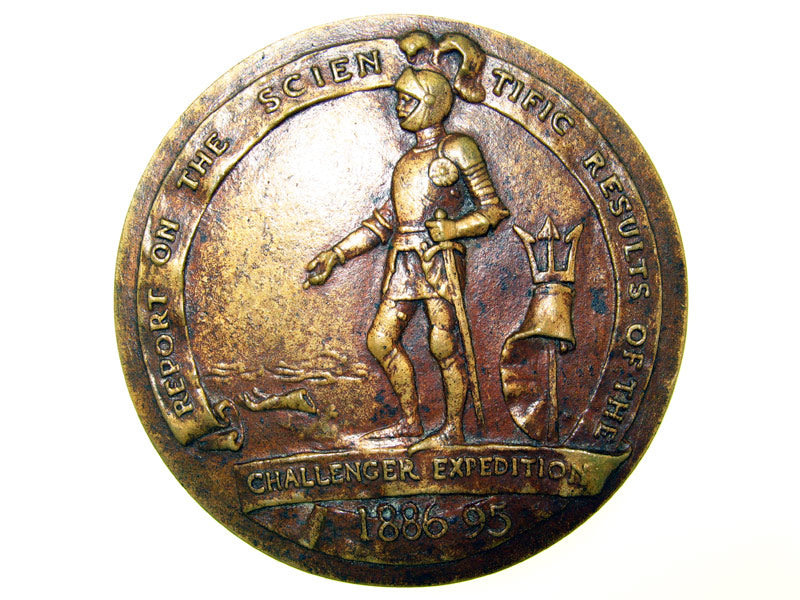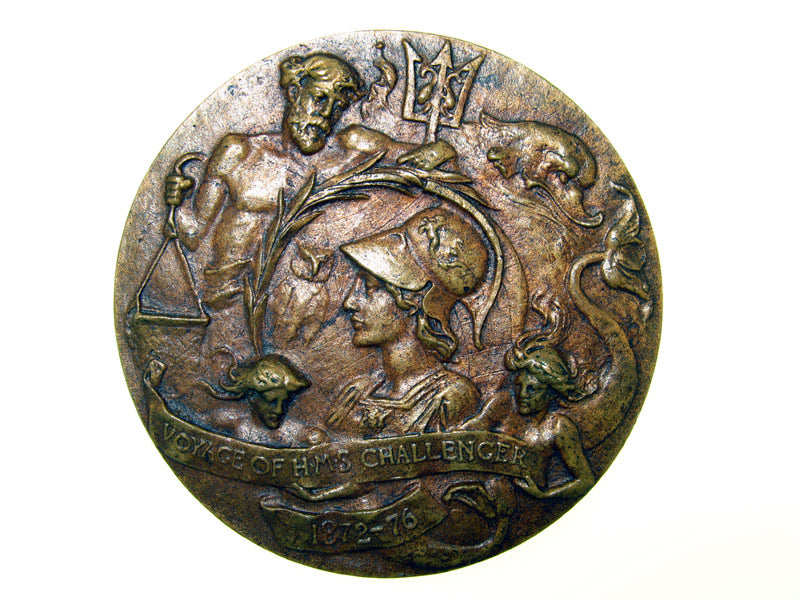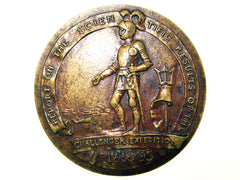Description
awarded to Dr. George Busk, a noted scientist and contemporary of Charles Darwin, who successfully nominated the latter for the Royal Society?s coveted Copley Medal.Medal for the Expedition of H.M.S. Challenger 1872-76 and the subsequent scientific reports 1886-95, Neptune, left hand holding a triangle and the right arm encircling a trident and resting on a wreath, below which, the helmeted bust of Britannia left, surrounded by dolphins and mermaids, with inscription on ribbon below, ?Voyage of H.M.S. Challenger, 1872-76?, reverse, armoured medieval knight left with gauntlet at his feet, a ribbon in part entwined around a trident bears the inscription, ?Report on the Scientific Results of the Challenger Expedition 1886-95? (George Busk), 75mm., bronze, good very fine. Medallic References: B.H.M. 3487 and Eimer 1797; a total of 120 such awards were issued, The Challenger Medal Roll (1895), by Glenn M. Stein, F.R.G.S., recording only eight known examples, some of which are still in family hands, while others reside in institutions - Busk's example was issued posthumously on 23 December 1895.George Busk was born in St. Petersburg in August 1807, the second son of Robert Busk, a merchant in that city. After receiving his initial education at Dr. Hartley's School, Bingley, Yorkshire, Busk studied medicine at St. Thomas's Hospital, London. Thereafter, he spent six years as an articled student with George Beaman, under the aegis of the Royal College of Surgeons of England.Appointed to the Seamen's Hospital Society (S.H.S.) in 1831, having served briefly as Apothecary on the Society's first hospital ship, the Grampus, Busk joined the 104-gun ship Dreadnought as an Assistant Surgeon in the following year, aboard which ship he ?worked out the pathology of cholera, and made important observations on scurvy?: he was to remain a Surgeon with the S.H.S. for nearly 25 years, until retiring from surgical practice in 1855, though he held the post of Consulting Surgeon from 1866 until his death 20 years later.In December 1843, Busk became one of the original 300 Fellows of the Royal College of Surgeons. Besides his eventual Presidency of the same body in 1871, he subsequently occupied many influential positions in several learned scientific institutions, among them the Microscopial Society, Linnean Society, Zoological Society, and the Anthropological Institute, while in 1850 he was elected a Fellow of the Royal Society.The Darwin connection:Early in life he had established himself as a leading authority on Polyzoa, and as with all things he studied, was a patient and cautious investigator. The author of several works on varied scientific subjects, and a solid artist, he also wrote and drew about Polyzoa specimens brought back by Charles Darwin on the Beagle, the 1875-76 Arctic Expedition, and of course, Challenger. Indeed Busk was deeply involved in the debate on the theory of evolution and some sources state that he read the joint Darwin-Wallace paper at a meeting of the Linnean Society on 1 July 1858 - the paper was an important prelude to Darwin's On the Origin of Species by Natural Selection (1859) - but more recent research suggests it was the Society?s Secretary who read out the paper. Be that as it may, Busk did translate into English Professor Schaaffhausen's detailed description of a cranium discovered in the Neander Valley in 1857, two years before publication of Darwin's Origin, a translation that duly appeared in The Natural History Review for April 1861. In his related publication, The Neander Valley, Robert Silverberg states:?[Busk] addressed a group of English scientists that same month, displaying a plaster cast of the Neanderthal skull and a skull of a chimpanzee. He said he had "no doubt of the enormous antiquity" of the Neanderthal bones, and called attention to the way the shape of the skull approached "that of some of the higher apes." Neither Darwin nor his chief popularizer, Huxley, attended Busk's lecture, but the geologist David Lyell did, and he saw to it that the Neanderthal skull cast got to Huxley. Huxley reported, in 1863, that the skull was that of a primitive variety of man, ?different from Homo Sapiens but not wholly distinct anatomically?, though he admitted it was the most apelike human skull yet found - Huxley added cautiously that ?in no sense can the Neanderthal bones be regarded as the remains of a human being intermediate between men and apes?. ?In addition, in 1863, Busk came forward with a fossilized skull found in Gibraltar in 1848, and since preserved at the Natural History Museum, London. He realized it had Neanderthal characteristics, and on the basis of the two skulls, an assistant of Lyell's christened a new species of man in 1864, Homo neanderthalensis. As a result, along with Darwin's Origin, "Neanderthal man" rapidly became the centrepiece in the contemporary evolution controversy.In fact, Darwin and Busk had a close medical, as well as scientific, relationship. Darwin was plagued nearly all his adult life with stomach problems, and on his way to Malvern Wells in 1863, he stopped in London overnight to consult Busk, whom Hooker had recommended as having ?the most fertile brain of any man I know in regard of all such matters as your stomach? (letter from J. D. Hooker, dated 27 August 1863, refers). Moreover, following Darwin?s failure to gain the Royal Society?s coveted Copley Medal in 1862-63, as a result of the contentious nature of his Origin, it was Busk who nominated him again in 1864, this time for his researches in geology, zoology and botanical physiology, and the ploy worked, the membership present at a meeting held that November resolving by ballot that Darwin receive said Medal. Darwin did not attend the meeting at which the award was announced, fearing the excitement would make him seriously ill, and in his absence the Medal was received on his behalf by Busk, who handed it over to Darwin's brother - a few days later the great man wrote to Busk, thanking him for proposing him for the award (Darwin?s letter, dated 4 December 1864, refers).It was around this same time that a social club was formed by eminent scientists and called the "X Club", in order to prevent the members from drifting apart due to their various duties, and to further the cause of science. Much of the discussion at X Club meetings revolved around the affairs of the Royal Society, and in the year of the Club's founding, all except one member were Fellows, Thomas Huxley and Busk among them. Both of them were also involved in the Philosophical Club, a "think tank" within the Royal Society.Busk was awarded the Royal Medal of the Royal Society in 1871 ?for his researches in Zoology, Physiology and Comparative Anatomy?, followed by the Lyell Medal in 1878 and the Geological Society?s Wollaston Medal in 1885.As stated above, the award of his Challenger Medal was made posthumously in December 1895 - prior to the voyage of the Challenger in 1872, a Royal Society scientific party went aboard the "floating laboratory" anchored at Sheerness, and on deck had their photograph taken, among them Busk. His ?last labours? were devoted to the preparation of a report on the Polyzoa collected during the expedition, the first part of the work being completed in 1884, and he was in the process of finishing the second part at the time of his death in London in August 1886 - the proofs were later corrected by his elder daughter.During his lifetime, Busk donated mainly Bryozoan material to the Natural History Museum, London, and after his death, his daughters bequeathed the rest of his collection to the Museum - which amounted to several thousand specimens - as well as some books and drawings. The Museum also holds a proof copy of Busk's Challenger work, with his corrections and annotations, and his original drawings.Dr. G. C. Cook's words perhaps best sum up George Busk the man: ?In retrospect, Busk must surely have been one of th

